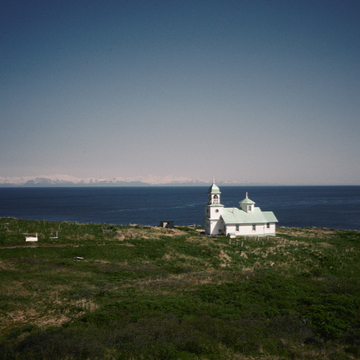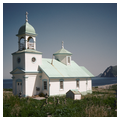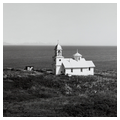The highly styled Ascension of Our Lord Chapel features a three-stage bell tower with an open belfry and an octagonal cupola over the nave. Painted white with lime-green roofs and light blue trim, the church is on a bluff, high above the river and the cannery activity that took place on the spit of land below.
The wood-framed chapel, covered with clapboards, has three distinct elements—sanctuary, nave, and bell tower. The gable-roofed nave and the slightly lower gable-roofed sanctuary have pedimented windows, with crosses in the pediments. A large tent-roofed octagonal cupola, with two windows, rises from the ridge of the nave.
The bell tower has a pedimented and pilastered entrance reminiscent of the Greek Revival style in the Lower 48. At the second level there are bull's-eye windows. Rising from the pyramidal roof is a third level, an open belfry, with round-arch openings, covered by an ogee-shaped dome. The interior is spacious and well lit, thanks to windows in the west wall of the nave and the octagonal cupola, which measures 17 feet in diameter. The paneled wainscot is painted bright green, the beaded-board walls white, and the ceiling light blue. The nine-bay iconostas has stylized pilasters and is divided vertically into three parts, including a row of icons above the iconostas proper. Icons on the iconostas and others on the side walls of the nave are oil painted on canvas.
This church, on the far side of Kodiak Island, is the oldest extant Russian Orthodox church in Alaska, as well as being one of the most professionally designed. Its size and style are probably attributable to the prosperity afforded by the rich salmon runs in the Karluk River, which brought canneries to this site in the 1880s. The first cannery was built by Messrs. Smith and Hirsch in 1882 and organized in 1884 into the Karluk Packing Company. Five other canneries were constructed near the mouth of the Karluk River within the next ten years; this area had one of the greatest salmon runs in the state.
When the Karluk Packing Company began constructing new houses for the Natives, a Native named Melety requested that the company build him a church instead. A stenciled plaque in the church reads “Melety's Memorial Church, Built in 11 June 1888, by Charlie Smith Hursh, Karluk, Alaska.” The canneries closed in the 1930s, and a severe storm in 1978 realigned the river and forced the removal of the village to a site about three-quarters of a mile upriver. The church was spared, however, and stands on a point of land as one of the most remarkable in Alaska.






